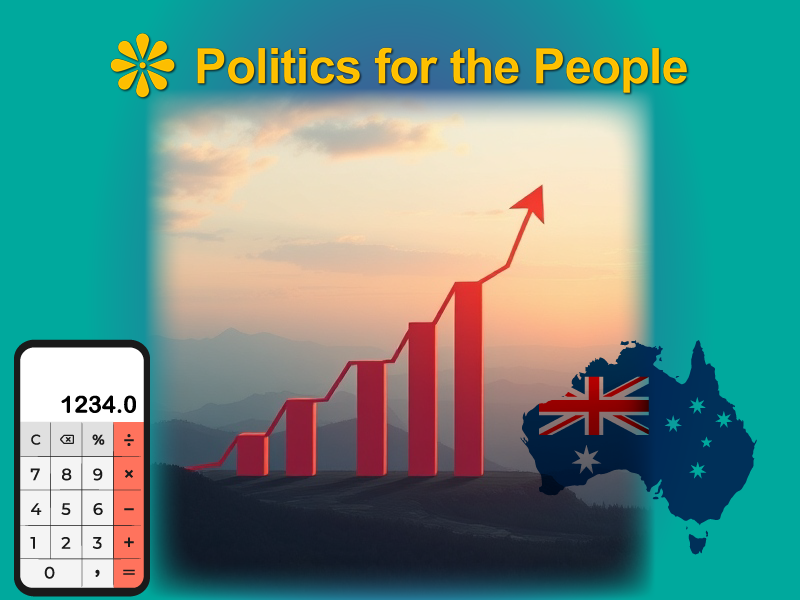Description: Australia’s Inflation
Discover the real causes of Australia’s inflation, focusing on corporate concentration and price gouging, and explore solutions for fair wages and economic balance.
Introduction
Australia’s inflation is on the rise, and it’s crucial to understand what’s really causing it. Contrary to widespread belief, blaming workers’ wages alone is an oversimplification. The truth is that corporate concentration and price gouging play a significant role in driving up prices and contributing to inflation. Let’s take a closer look at how these factors impact the economy and explore possible solutions that aim to ensure fair wages while tackling inflation.
Corporate Concentration and Its Effects on Inflation
The Rise of Corporate Concentration

Over the past few years, we’ve seen a worrying trend of increasing corporate concentration in various industries across Australia. This phenomenon occurs when a small number of large companies dominate a market, leading to reduced competition and higher barriers to entry for smaller firms. In such concentrated markets, dominant companies can use their position to set prices that maximize their own profits, often at the expense of consumers.
The Impact on Consumers
Consumers are the ones who withstand the worst of corporate concentration. With fewer choices and higher prices, the cost-of-living increases, contributing to inflation. This scenario is especially problematic in essential industries such as food, healthcare, and energy, where consumers cannot easily cut back on spending. For example, in the grocery sector, a few major retailers dominate the market, limiting competition and driving up prices for everyday essentials.
Price Gouging and Its Impact
Understanding Price Gouging
Price gouging involves charging excessively high prices for essential goods and services, often exploiting situations where consumers have limited alternatives. This practice is particularly prevalent during emergencies or periods of high demand, such as natural disasters or pandemics. Companies in sectors like pharmaceuticals and utilities have been known to engage in price gouging, capitalizing on their market power to boost profits.
Examples of Price Gouging

Pharmaceuticals and utilities are prime examples of industries where price gouging is prevalent. In the pharmaceutical industry, life-saving medications can be priced exorbitantly high, leaving patients with no choice but to pay the inflated prices. For instance, the cost of insulin has skyrocketed, putting a significant financial burden on diabetics. Similarly, in the utilities sector, essential services such as electricity and water are often priced unfairly, affecting household budgets significantly. During heatwaves or cold snaps, utility companies have been known to raise prices, taking advantage of increased demand.
The Plight of Workers
Stagnant Wage Growth
While it’s often easy to blame workers’ wages for inflation, this viewpoint fails to consider the reality of stagnant wage growth faced by many Australians in recent years. Despite rising productivity and corporate profits, wage growth has remained sluggish. This has led to an increasing income gap between workers and corporate executives, showing that wages aren’t the primary driver of inflation. Instead, workers’ wages have struggled to keep up with the rising cost of living, making it even more challenging for individuals and families to make ends meet.
Income Inequality
Income inequality in Australia has been a growing concern over the past few decades. The gap between the highest earners and the average worker has widened significantly, creating a more polarized society. This inequality is not just a matter of statistics; it has real-world implications for economic stability and social cohesion.
Causes of Income Inequality
Several factors contribute to the widening income gap:
1. Stagnant Wages: While corporate profits and executive salaries have surged, wage growth for the average worker has remained flat. This stagnation means that workers’ incomes are not keeping pace with the rising cost of living, worsening financial stress.
2. Technological Advancements: Automation and digital technologies have disproportionately helped high-skilled workers and executives, while many lower-skilled jobs have been outsourced or eliminated. This shift has resulted in higher incomes for those at the top, while many workers have seen their jobs become more precarious.
3. Globalization: The integration of global markets has led to increased competition, putting downward pressure on wages in certain industries. While some sectors have thrived, others have struggled to adapt, leading to job losses and wage stagnation in affected areas.
4. Tax Policies: Tax cuts for high-income earners and corporations have also contributed to income inequality. These policies often help the wealthy more than the middle and lower-income groups, further widening the income gap.
Effects of Income Inequality
The consequences of growing income inequality are far-reaching:
1. Economic Instability: Elevated levels of income inequality can lead to reduced consumer spending, as a substantial part of the population has less disposable income. This reduction in spending can slow economic growth and increase the risk of economic downturns.
2. Social Tension: Income inequality can foster social discontent and division. When a sizeable part of the population feels left behind, it can lead to increased frustration, protests, and a lack of trust in institutions.
3. Health and Education Disparities: Income inequality often translates into disparities in access to quality healthcare and education. Lower-income individuals may struggle to afford essential services, leading to worse health outcomes and limited educational opportunities, perpetuating the cycle of poverty.
4. Political Polarization: Economic inequality can contribute to political polarization, as different income groups may have divergent interests and priorities. This polarization can make it more challenging to implement policies that help the broader population.
Addressing Income Inequality
To address income inequality, a combination of policy measures is needed:
1. Progressive Taxation: Implementing a more progressive tax system can help redistribute wealth more fairly. Higher taxes on the wealthy and corporations can fund public services and social programs that help everyone.
2. Minimum Wage Increases: Raising the minimum wage can help ensure that workers earn a living wage that keeps pace with the cost of living. This increase can reduce poverty and boost consumer spending.
3. Education and Training Programs: Investing in education and job training programs can help workers adapt to changing job markets and secure better-paying jobs. These programs can also reduce the skills gap and increase economic mobility.
4. Strengthening Labor Rights: Enhancing labor rights and supporting unions can empower workers to negotiate for better wages and working conditions. Stronger labor protections can help ensure that workers receive a fair share of economic gains.
By implementing these measures, Australia can work towards reducing income inequality, fostering a more inclusive economy, and promoting long-term social and economic stability.
Finding a Balance: Fair Wages and Combating Inflation
Encouraging Competition
To address the dual challenge of ensuring fair wages for workers and combating inflation, we need a multifaceted approach. Governments must implement policies that promote healthy competition and prevent market concentration. Strong antitrust regulations and their effective enforcement can level the playing field, giving consumers more choices and preventing corporations from having undue control over prices. For example, breaking up monopolies or preventing mergers that lead to excessive market power can enhance competition and lower prices.
Price Controls and Transparency
Regulatory measures can be put in place to curb price gouging, especially in essential industries. Transparent pricing mechanisms and oversight can prevent companies from taking advantage of their market power and charging exorbitant prices. Ensuring that pricing is fair and reflective of actual costs can help mitigate inflationary pressures. For instance, implementing price caps on essential medications or utilities during emergencies can protect consumers from exploitative practices.
Investing in Workers
Increasing the minimum wage and advocating for fair wages across industries is crucial to improving the living standards of workers and boosting their purchasing power. Ensuring that wage growth outpaces inflation is essential for workers to afford the rising costs of goods and services. Policies that support worker training and development can also enhance productivity and economic growth. Investing in education and skills development ensures that workers can adapt to changing job market demands and contribute more effectively to the economy.
Empowering Consumers
Educating consumers about their rights and available options can help mitigate the impact of price gouging. Through informative campaigns, individuals can gain the knowledge needed to make informed purchasing decisions, find instances of price manipulation, and report such practices. Empowering consumers to make better choices can drive demand for fair pricing and quality services. For example, consumer advocacy groups can play a vital role in raising awareness about unfair pricing practices and lobbying for stronger consumer protection laws.
Conclusion
Corporate concentration and price gouging are key contributors to inflation in Australia, overshadowing the role of workers’ wages. Tackling these issues requires a comprehensive approach that promotes competition, curtails price gouging, invests in workers, and empowers consumers. By addressing these factors, Australia can strive for a fairer and more balanced economy that helps both workers and consumers while effectively combating inflation.
Question for Readers
How do you think we can effectively address inflation while ensuring fair wages for workers?
Call to Action
Join the discussion on tackling inflation in Australia. Advocate for policies that promote competition, fair pricing, and wage growth. Share your thoughts and ideas to help shape a more fairer economic future.
Share Request: If you found this article insightful, please share it with your contacts and on social media to help spread awareness and encourage discussions on this crucial topic.
References:
Why the RBA thinks if there must be a recession, there will be a recession: https://thenewdaily.com.au/finance/2023/06/01/recession-rba-alan-kohler/
Profits continue to grow faster than wages: https://australiainstitute.org.au/post/soaring-profits-weak-wages/
You are being lied to about inflation: https://youtu.be/Zi4KMCQuQYE
Quarterly growth in wages and profits in Australia 2018 to 2020: https://www.statista.com/statistics/1229140/australia-quarterly-growth-in-wages-and-profits/
The economy is growing but workers are not getting the benefits: https://www.abc.net.au/news/2022-06-03/gdp-is-growing-but-workers-are-not-getting-the-economic-benefits/101122124
Australian CEOs earn 100 times more than the average worker: https://www.australianunions.org.au/2022/07/13/australian-ceos-earn-100-times-more-than-the-average-worker/

